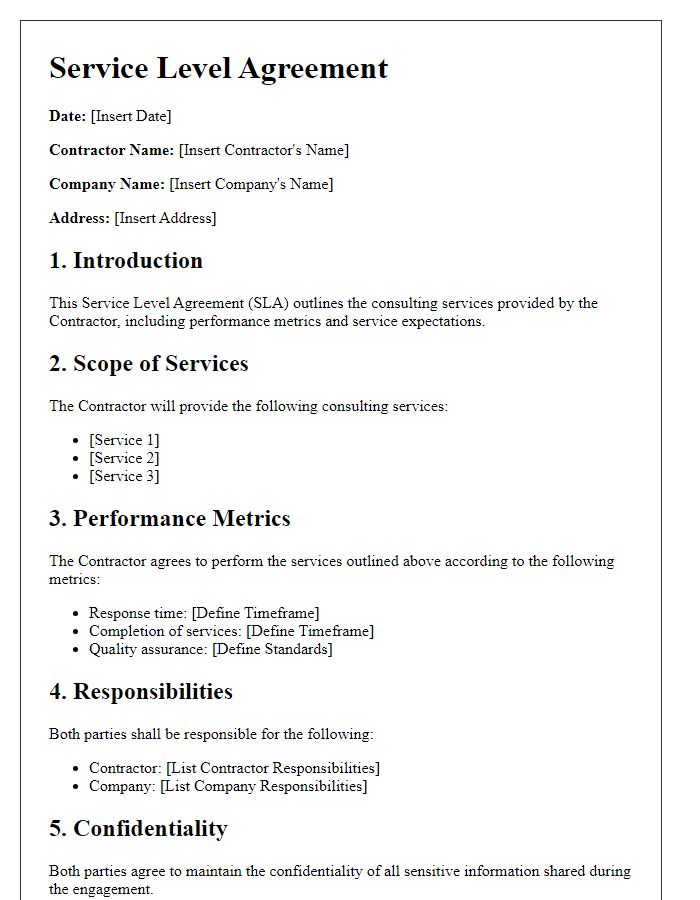Are you considering hiring a contractor and want to ensure that everything runs smoothly? Drafting a service level agreement (SLA) is a crucial step in setting the foundation for a successful partnership. It outlines expectations, responsibilities, and performance metrics, protecting both parties and enhancing collaboration. If you're ready to delve deeper into crafting an effective SLA, read on for a detailed guide!

Scope of Services
The scope of services in a contractor service level agreement outlines defined responsibilities and tasks expected from the contractor. Key services may include site preparation, project management, and compliance with local regulations, particularly for construction contracts in areas like California and Texas. Additional specifications may encompass material procurement, employing certified subcontractors, and ensuring adherence to safety standards set by OSHA. Performance metrics should be established, including timelines for project milestones and quality assurance measures, ensuring that the contractor meets agreed-upon benchmarks. Effective communication protocols must be defined, highlighting regular progress reports and updates, fostering transparency and accountability throughout the project duration.
Performance Standards
Performance standards in a contractor service level agreement (SLA) are crucial for setting clear expectations and ensuring quality service delivery. Specific metrics, such as response time (typically within 24 hours for urgent requests), resolution time (often within 72 hours for complex issues), and service availability percentage (commonly 99.9% uptime for critical services), establish benchmarks for performance. Additionally, compliance with safety regulations (like OSHA standards) is essential in construction or maintenance services, ensuring worker safety and risk management. Service quality assessments, often conducted through customer feedback surveys (using a five-point Likert scale for effectiveness), and regular performance reviews (quarterly, for instance) can verify adherence to these standards. Performance indicators must also align with industry best practices (such as ISO 9001 standards for quality management) to guarantee a reliable contractor partnership.
Payment Terms
Payment terms in a contractor service level agreement specify the conditions under which payments are made to contractors for services rendered. Clear outlines of payment schedules can enhance financial transparency, typically encompassing milestones or project deliverables achieved. The due date for payments often falls within 30 days following the receipt of an invoice, which is a common practice in many industries. Penalties for late payments may be included, often set at a percentage of the overdue amount per month, to incentivize timely payments. Furthermore, the agreement might stipulate payment methods, such as bank transfers or checks, and conditions for withholding fees in case of non-compliance with service quality standards outlined elsewhere in the agreement, thus ensuring accountability and enforceability.
Confidentiality Clause
In a contractor service level agreement, a confidentiality clause may stipulate that both parties must protect any sensitive information exchanged during the contract duration. This includes trade secrets, financial data, and client lists. The clause typically specifies a time frame--often two to five years--during which this information must remain confidential. Breach of the confidentiality obligation could lead to legal repercussions, including potential damages. Exceptions might apply for information already in the public domain or required to be disclosed by law. Confidentiality ensures trust and security in the contractual relationship.
Termination Conditions
Termination conditions in a contractor service level agreement outline the specific circumstances under which either party may terminate the agreement. Common conditions include failure to meet performance benchmarks, breach of contract terms, or statutory compliance violations. Additionally, notice periods ranging from 30 to 90 days may be stipulated, allowing time for dispute resolution or corrective measures. Financial repercussions, such as penalties or forfeiture of deposits, could also apply. Specifics regarding the return of proprietary information, equipment, and any outstanding payments upon termination are crucial to ensure a smooth transition and mitigate potential conflicts.
Letter Template For Contractor Service Level Agreement Samples
Letter template of Contractor Service Level Agreement for Construction Projects

Letter template of Contractor Service Level Agreement for Maintenance Services

Letter template of Contractor Service Level Agreement for Landscaping Services

Letter template of Contractor Service Level Agreement for Cleaning Services

Letter template of Contractor Service Level Agreement for Consulting Services

Letter template of Contractor Service Level Agreement for Event Management

Letter template of Contractor Service Level Agreement for Transportation Services

Letter template of Contractor Service Level Agreement for Security Services






Comments